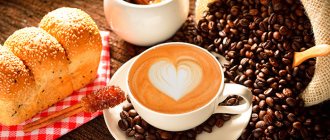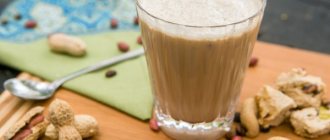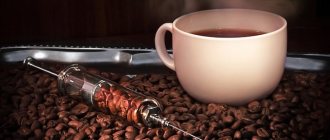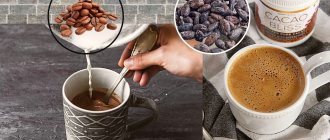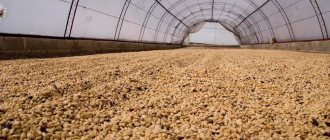See on topic:
Coffee and everything about it
All the secrets of coffee in one article
Espresso is an Italian word that translates as “pressed, squeezed.”
Italy is a country of coffee and the Italians’ love for this drink is limitless. For many Italians, coffee is the food and water they can't resist. Drinking coffee for breakfast for the indigenous population of Italy is a real ritual that regulates the daily routine and life rhythm of each person.
After the invention of the coffee machine in 1901 by Italian scientist Luigi Bezzera, espresso came to mean strong coffee prepared using a special device with a lever. The very first coffee machine was completely mechanical: a person lowered a lever to artificially create the necessary pressure to brew coffee. This fully mechanical machine is believed to be the ancestor of modern espresso coffee makers.
To enjoy the real taste of espresso, you need to pour 7-9 g of freshly ground coffee beans into the coffee machine. About 30 ml of water heated to 90 degrees will be passed through the grains under a pressure of 9 bar. This method of preparing coffee allows you to extract the maximum amount of oils from the beans, which is why espresso has such a rich taste. Espresso preparation time ranges from 20 to 30 seconds. Real espresso should have a thick, creamy foam and this drink should be drunk immediately after preparation so that the coffee does not lose its real aroma.
Cappuccino
Cappuccino is one of the most popular espresso-based drinks. Cappuccino is the same espresso with hot milk added. The milk is whipped into a stiff foam using a powerful jet of steam, and then gradually introduced into the espresso brewed in the coffee machine. Italians usually drink cappuccino before lunch to boost their energy for the day ahead. It is believed that only tourists and fools drink cappuccino in the afternoon. Cappuccino tastes best when drunk from heated porcelain cups. The maximum dose of cappuccino is 5 cups of coffee per day.
Latte
This is one of the simplest coffee drinks. Its distinctive feature is the ratio of milk to coffee three to one (three parts milk to one part coffee). It is prepared as follows: first pour milk into the bottom of a special glass, then espresso, and put milk foam on top.
All layers must be poured very carefully so that they do not mix. Lattes with additives made from a wide variety of syrups are no less popular. A taste that absolutely everyone should try is currant syrup.
Italy is considered the birthplace of latte, however, it is most popular in the USA. There, the standard portion of this drink is 500 ml, in contrast to the prescribed portion of 200 ml.
A flat white is a latte with double the dose of espresso and boiled milk without creating foam. This drink is considered correct if you drink both coffee and milk at the same time. If you add vodka to a cooled flat white, you get a very original cocktail.
Viennese coffee
Viennese coffee shops are famous all over the world. Viennese coffee is not just an invigorating drink, it is a real delicacy. The first coffee shop in Vienna was opened in the 17th century, it was then that its owner introduced the tradition of filtering coffee from the grounds, adding cream and sugar to it. This is the kind of coffee that came to be called “Viennese coffee.” Today there are many varieties of Viennese coffee. But the classic of the genre is high-quality espresso with the addition of frothed milk under the most delicate blanket of whipped cream.
How is Americano different from espresso?
Initially, Americano was not supposed to have foam.
Americano is a simple coffee made in a filter coffee maker. They say that during World War II, American soldiers asked Italian bartenders to brew them the same coffee that they drank at home in the United States, and the bartenders simply diluted the ready-made espresso with hot water.
Americano is not as strong as espresso (however, it has the same amount of caffeine, just in less concentration). Americano has appealed to Europeans who are concerned about their health.
Italian Americano did not have the coffee foam familiar to Europeans, so the Swiss proposed a new way of preparing it - not adding water to the espresso, but, on the contrary, carefully pouring coffee into a cup of hot water, then foam will remain on its surface. The ideal proportion is one part espresso to three parts hot water, and the result should be 120 ml of drink.
Espresso based
Coffee lovers supplement classic espresso with sugar, milk or cream, lemon, alcohol and ice cream, and simply change the ratio of coffee and water. The result is more than a dozen recipes.
Espresso
Espresso is figuratively called coffee juice. A small (30 g) portion of an exceptionally aromatic drink with a rich taste does not need any additions. It is prepared from finely ground coffee in coffee machines or carob coffee makers under pressure, therefore it has a characteristic dense foam (creama). For serving, special “demitasse” cups are used - small but thick-walled.
Doppio
Double espresso for those who want to invigorate themselves. Drink volume – 60 ml. Like regular, served without sugar and dessert.
Ristretto
A serving is literally enough for one sip (up to 20 ml). Taste buds will be pleasantly surprised by the strength of the taste of this concentrated drink. Moreover, the amount of caffeine per 100 ml is lower here due to the shorter preparation time.
Lungo
The opposite of ristretto. The cooking time has been increased and therefore the serving size is 50 ml. A strong and bitter option for the first half of the day.
Lungo, whose volume is close to doppio, differs from it in its higher caffeine content, bitter taste and less pronounced aroma.
Americano
The difference between espresso and Americano is the serving size and concentration of coffee. This is 200-400 ml of espresso diluted with boiling water. The taste of the drink is unsaturated, so it is often supplemented with sugar and milk. Served with dessert. Italians disdain this type of coffee, considering it tasteless.
Coffee and milk drinks
Varieties of coffee in which the main ingredient is milk or cream are also very common. They contain less caffeine, but more calories, have a delicate creamy taste and often act as independent desserts. Sugar and various syrups are added to all types of coffee milkshakes at will: warm milk in their composition adds a slight sweetness.
Cappuccino
The most popular type of coffee-cream cocktail. Milk foam covers the espresso, and there is 2 times more milk than coffee. It is possible to add vanilla for flavor. Dense foam allows you to create drawings using the latte art technique.
Latte
The differences between coffee latte and cappuccino are in the proportions: here milk predominates. Therefore, the caffeine content is low and this type of coffee cocktail is suitable for the evening. Often complemented with sweet flavored syrups.
- This is interesting: What is the difference between a latte and a cappuccino?
Latte macchiato
A three-layer drink made from coffee, milk and creamy foam is usually served in tall glasses and drunk through a straw. More calories than a regular latte.
Raf coffee
A sweet and nutritious dessert coffee made with espresso, cream and vanilla sugar. All ingredients are whisked together. Honey raf is also prepared.
Breve
This type of coffee drink is characterized by a small volume - 60 ml. The composition is reminiscent of a macchiato, but this warm coffee-milk-cream cocktail is not flaky. Breve is not whipped, but simply mixed. Good for evening coffee drinks.
Flat white
The name translated means “flat white”. This is coffee (60 ml) with the addition of hot milk (120 ml) without whipping. It differs from cappuccino in the absence of foam. Popular in Australia.
- Read more: Flat white coffee – recipe, difference from cappuccino
Mocha (mochaccino)
A chocolate-milk-coffee four-layer cocktail for those with a sweet tooth, served in tall glasses decorated with foam and chocolate chips. A complete nutritious dessert containing 260 kcal per 100 g.
Quick comparison table
To better understand the differences between coffee products, you should pay attention to the information presented in the table:
| Criterion | Latte | Cappuccino |
| Coffee content | Double espresso – 60 milliliters | Double espresso – 60 milliliters |
| Milk quantity 2-3.5% | 180 milliliters | 120 milliliters |
| Foam thickness | 12-20 millimeters | not less than 10 millimeters |
| Coffee/milk/foam ratio | 1/4-2/4-1/4 | 1/3-1/3-1/3 |
| Serving utensils | Cup or glass | Cup |
The nutritional value
Cappuccinos, macchiatos, and lattes contain different amounts of milk and foam, which may slightly change their nutrient profiles.
Their nutrient content is also affected by the type of milk used, as well as added sugar or sweeteners.
Lattes contain the most milk and are higher in calories, fat and protein.
Cappuccino contains slightly less milk, but still provides the body with enough calories, protein and fat in each serving.
On the other hand, a macchiato contains only a little milk and significantly less calories, fat and protein.
Here is a comparison of three drinks (1, 2, 3):
| Drink type | Calories | Squirrels | Total fat | Carbohydrates |
| Latte (475 ml) | 206 kcal | 13 grams | 8 grams | 20.5 grams |
| Cappuccino (475 ml) | 130 kcal | 8 grams | 5 grams | 13 grams |
| Macchiato (60 ml) | 13 kcal | 0.7 grams | 0.5 grams | 1.6 grams |
Summary:
Lattes, cappuccinos, and macchiatos contain varying amounts of calories, carbohydrates, protein, and fat.
Differences between Latte Macchiato and Cappuccino, Irish Coffee and Macchiato
The closest “relatives” that differ from latte macchiato are cappuccino, classic latte, and Irish coffee. Mocha is distinguished from them by the following features:
- at the time of preparing the drink, espresso is added to the already prepared frothed milk (when preparing cappuccino and latte, milk is added last);
- three layers are clearly visible at the moment the cocktail is served (they mix independently when cooled);
- Latte macchiato has more milk base than classic macchiato or cappuccino;
- non-alcoholic base (for example, the Irish coffee recipe includes cream and Irish whiskey).
Cappuccino and other types of coffee with milk
In a “correct” cappuccino, the foam is so strong that the sugar does not sink on it.
Cappuccino is a coffee drink in which a third part of espresso, a third part of boiled milk and a third part of frothed milk are mixed (milk for cappuccino is frothed using steam). It is because of the lush foam on top, slightly reminiscent of the hood of a Capuchin monk, that this drink acquired its name.
The foam prevents the aroma from evaporating and helps the cappuccino stay warm longer. First prepare the espresso, and then carefully pour the frothed milk into the center of the cup. In a well-prepared cappuccino, the foam is so strong that if you put a small spoonful of sugar on it, it will not sink. Although the Italians themselves always drink cappuccino without sugar, and only before lunch. The standard serving is 150 ml.
Flat white coffee is a drink based on one part double espresso, diluted with two parts boiled, but not foamed, milk.
This coffee, the highlight of which is a rich coffee taste with a noticeable milky note, is gaining more and more popularity among coffee lovers. A wonderful cocktail with vodka is made using cooled flat white coffee.
Torre is a layered drink, much like a latte and cappuccino at the same time. This is espresso covered with fluffy milk foam, drier and denser than cappuccino.
Mocha is a mixture of espresso, hot chocolate, milk and whipped cream. Ideally, for every portion of espresso there is a portion of hot chocolate, boiled milk and whipped cream.
Most often, chocolate syrup is added to mocha instead of hot chocolate, making mocha the most nutritious of coffee drinks. It has much more caffeine than regular espresso.
conclusions
From the above it is clear that espresso becomes the basis for most coffee drinks. This is a basic type; when different ingredients are added to it, drinks with original, different tastes are obtained. But even from the same ingredients, you can make drinks that differ in taste if you vary the concentration and proportions. For example, the ingredient composition of latte and cappuccino is the same, but these drinks are prepared according to different recipes, which affects the taste impression when tasting.
Even simple coffee without added ingredients can have different flavors, depending on the concentration of the coffee mass, the preparation method and the type of coffee beans. For example, dense, rich coffee in a small cup is espresso, and diluted with water, a lighter and fresher version is Americano.
Expert opinion
Karnaukh Ekaterina Vladimirovna
Graduated from the National University of Shipbuilding, majoring in Enterprise Economics
Coffee goes well with many ingredients. An interesting taste is obtained by adding citrus juice or zest, strong alcohol, and dairy products. The combination with vanilla, cloves, cinnamon, and chocolate is wonderful.
Preparation technology has a great influence on the taste of coffee drinks. The fastest and easiest method is to pour boiling water directly into the cup and wait a few minutes. Despite the primitiveness of this method, it is considered professional, that is, it is used by specialists to evaluate taste and aroma qualities.
Another simple traditional cooking method is in a Turk. In this case, the drink also reveals the aroma well, remains “alive” and multifaceted. This method of preparation is respected by true connoisseurs of this noble drink.
Ordinary people prefer to use coffee machines. The devices operate on different principles, and taste also depends on this. Devices like a French press press and infuse the coffee mass, turning it into a strong drink. Other devices are based on a filtration system, such as the pour-over.

